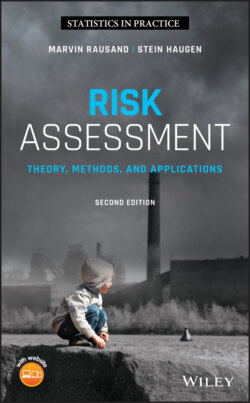Читать книгу Risk Assessment - Marvin Rausand - Страница 104
2.5.4 Consequence Spectrum
ОглавлениеA hazardous event (or end state) may lead to a number of potential consequences , , …, . The probability that consequence will occur depends on the physical situation and whether or not the barriers are functioning. The possible consequences and the associated probabilities resulting from the hazardous event are shown in Figure 2.5 .
Figure 2.5 Consequence spectrum for a hazardous event.
The diagram in Figure 2.5 is called a consequence spectrum, a risk picture, or a risk profile related to hazardous event . The consequence spectrum may also be written as a vector:
(2.8)
In Figure 2.5 and in the vector (2.8), we have tacitly assumed that the consequences can be classified into a finite number ( ) of discrete consequences. This is often a simplification that we make in risk analysis.
A study object may lead to several potential hazardous events. It may therefore be relevant to establish the consequence spectrum for the study object rather than for a single hazardous event. Each hazardous event then has a consequence spectrum, as shown in Figure 2.5 . Combining the consequence spectra for all the relevant hazardous events yields the consequence spectrum for the study object. This consequence spectrum has the same form as for a hazardous event. The consequence spectrum may also be presented in a table, as shown in Table 2.8 .
Table 2.8 Consequence spectrum for a study object (example).
| Consequence | Probability | |
| 1 | Operator is killed | 0.001 |
| 2 | Operator is permanently disabled | 0.004 |
| 3 | Operator is temporarily injured | 0.008 |
| m | Minor material damage | 0.450 |
The probability associated with each consequence lies between 0 and 1, where means that the consequence is impossible and signals that it will always occur. Both extremities correspond to a fatalistic world view in which the future is conceived of as independent of human activities. According to Rosa (1998), the term risk would be of no use in such a world of predetermined outcomes. At the heart of the concept of risk is thus the idea that the consequences admit to some degree of uncertainty.
In some cases, it may be possible to measure the consequences of a hazardous event to the different assets in a common unit (e.g. in US dollars). Let denote the loss in dollars if consequence occurs, for . The loss spectrum for the hazardous event can then be pictured as in Figure 2.6 .
Figure 2.6 Loss spectrum for a hazardous event .
In this case, it may be meaningful to talk about the mean consequence or mean loss if the hazardous event should occur
(2.9)
Observe that (2.9) is the conditional mean loss given that the specified hazardous event has occurred. The minimum and maximum loss and the standard deviation may easily be provided. In cases where the consequences cannot be easily measured with a common unit, it is considered much more meaningful to present the entire consequence spectrum to the decision‐maker, primarily for the whole study object but also for the most critical hazardous events (or end states).
